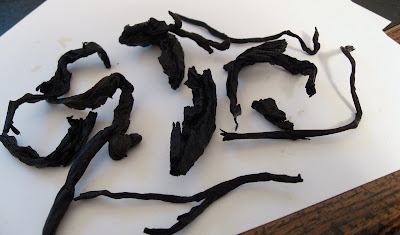
Come to think of it, I've never seen border tea compressed into anything, it's always been kept loose. Border tea is pu-erh tea from the border regions of other countries around China, where the environment is similar to the growing regions of China. The dry leaf carries almost no smells. Suprising, yet expected, the leaf is quite whole. Even after 20, 30 years even, the Vietnamese prevail with keeping their leaf wholer than any other country.

The smell comes out dry and sweet. Clean, smells lightly of wood and dirt... not very complex. The taste is smooth and sweet, clean, dry and lightly woodsy. The tea seems to be rich, yet very lacking in flavor. A very contradictory and confusing taste experience. It loses character after around the 4th steep (~15s steeps), and I notice that the leaves are still hard and unopened. A 30 second steep teases some flavor back into the tea. Increasing steep time sooner than usual and giving it much longer steeps does let this tea leech out a few more good cups to give out completely around the 8th.

The overall picture of this tea is that it is very bland, uncomplex. On the up side, the taste is very clean, sweet, and accessible. After the session seems over, with most of the taste having dissipated and the color of the liquor lightening, the leaves are still not opened fully. Messing around with the leaves reveals that they have an almost dry feel to them, even when wet. Very rough, black as midnight. The browner leaves are softer. The large, whole nature of the leaf that I first thought was a good quality, may be the reason why this tea is so plain. Next time, I'll remind myself to crumble the leaves somewhat before drinking. Can't expect much from border tea.
0 comments:
Post a Comment